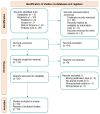Bioactive-Glass-Based Materials with Possible Application in Diabetic Wound Healing: A Systematic Review
- PMID: 38256225
- PMCID: PMC10816070
- DOI: 10.3390/ijms25021152
Bioactive-Glass-Based Materials with Possible Application in Diabetic Wound Healing: A Systematic Review
Abstract
Diabetes affected 537 million adults in 2021, costing a total of USD 966 billion dollars in healthcare. One of the most common complications associated with diabetes corresponds to the development of diabetic foot ulcers (DFUs). DFUs affect around 15% of diabetic patients; these ulcers have impaired healing due to neuropathy, arterial disease, infection, and aberrant extracellular matrix (ECM) degradation, among other factors. The bioactive-glass-based materials discussed in this systematic review show promising results in accelerating diabetic wound healing. It can be concluded that the addition of BG is extremely valuable with regard to the wound healing rate and wound healing quality, since BG activates fibroblasts, enhances M1-to-M2 phenotype switching, induces angiogenesis, and initiates the formation of granulation tissue and re-epithelization of the wound. In addition, a higher density and deposition and better organization of collagen type III are seen. This systematic review was made using the PRISMA guideline and intends to contribute to the advancement of diabetic wound healing therapeutic strategies development by providing an overview of the materials currently being developed and their effect in diabetic wound healing in vitro and in vivo.
Keywords: angiogenesis; bioactive glass; diabetic wounds; osteomyelitis; wound healing.
Conflict of interest statement
The authors declare no conflict of interest.
Figures


Similar articles
-
Growth factors for treating diabetic foot ulcers.Cochrane Database Syst Rev. 2015 Oct 28;2015(10):CD008548. doi: 10.1002/14651858.CD008548.pub2. Cochrane Database Syst Rev. 2015. PMID: 26509249 Free PMC article.
-
Psychological interventions for treating foot ulcers, and preventing their recurrence, in people with diabetes.Cochrane Database Syst Rev. 2021 Feb 8;2(2):CD012835. doi: 10.1002/14651858.CD012835.pub2. Cochrane Database Syst Rev. 2021. PMID: 35653236 Free PMC article.
-
Topical antimicrobial agents for treating foot ulcers in people with diabetes.Cochrane Database Syst Rev. 2017 Jun 14;6(6):CD011038. doi: 10.1002/14651858.CD011038.pub2. Cochrane Database Syst Rev. 2017. PMID: 28613416 Free PMC article.
-
Platelet-rich plasma for the treatment of diabetic foot ulcer: a systematic review.Front Endocrinol (Lausanne). 2023 Nov 18;14:1256081. doi: 10.3389/fendo.2023.1256081. eCollection 2023. Front Endocrinol (Lausanne). 2023. PMID: 38169990 Free PMC article.
-
Hyperbaric oxygen therapy for chronic wounds.Cochrane Database Syst Rev. 2004;(2):CD004123. doi: 10.1002/14651858.CD004123.pub2. Cochrane Database Syst Rev. 2004. Update in: Cochrane Database Syst Rev. 2012 Apr 18;(4):CD004123. doi: 10.1002/14651858.CD004123.pub3. PMID: 15106239 Updated.
Cited by
-
Advances and Challenges in Immune-Modulatory Biomaterials for Wound Healing Applications.Pharmaceutics. 2024 Jul 26;16(8):990. doi: 10.3390/pharmaceutics16080990. Pharmaceutics. 2024. PMID: 39204335 Free PMC article. Review.
-
Nanomedicine and Its Role in Surgical Wound Infections: A Practical Approach.Bioengineering (Basel). 2025 Jan 31;12(2):137. doi: 10.3390/bioengineering12020137. Bioengineering (Basel). 2025. PMID: 40001657 Free PMC article. Review.
-
Applications and prospects of biomaterials in diabetes management.Front Bioeng Biotechnol. 2025 Mar 7;13:1547343. doi: 10.3389/fbioe.2025.1547343. eCollection 2025. Front Bioeng Biotechnol. 2025. PMID: 40124248 Free PMC article. Review.
-
Intelligent hydrogel-based dressings for treatment of chronic diabetic wounds.World J Diabetes. 2025 May 15;16(5):104937. doi: 10.4239/wjd.v16.i5.104937. World J Diabetes. 2025. PMID: 40487617 Free PMC article. Review.
References
-
- International Diabetes Federation . IDF Diabetes Atlas. 10th ed. International Diabetes Federation; Brussels, Belgium: 2021.
-
- Ozougwu J.C., Obimba K.C., Belonwu C.D., Unakalamba C.B. The pathogenesis and pathophysiology of type 1 and type 2 diabetes mellitus. J. Physiol. Pathophysiol. 2013;4:46–57. doi: 10.5897/JPAP2013.0001. - DOI
-
- Porta M., Curletto G., Cipullo D., Rigault de la Longrais R., Trento M., Passera P., Viola A., Di Miceli S., Cenci A., Dalmasso P., et al. Estimating the Delay Between Onset and Diagnosis of Type 2 Diabetes From the Time Course of Retinopathy Prevalence. Diabetes Care. 2014;37:1668–1674. doi: 10.2337/dc13-2101. - DOI - PubMed
Publication types
MeSH terms
Substances
LinkOut - more resources
Full Text Sources
Medical

